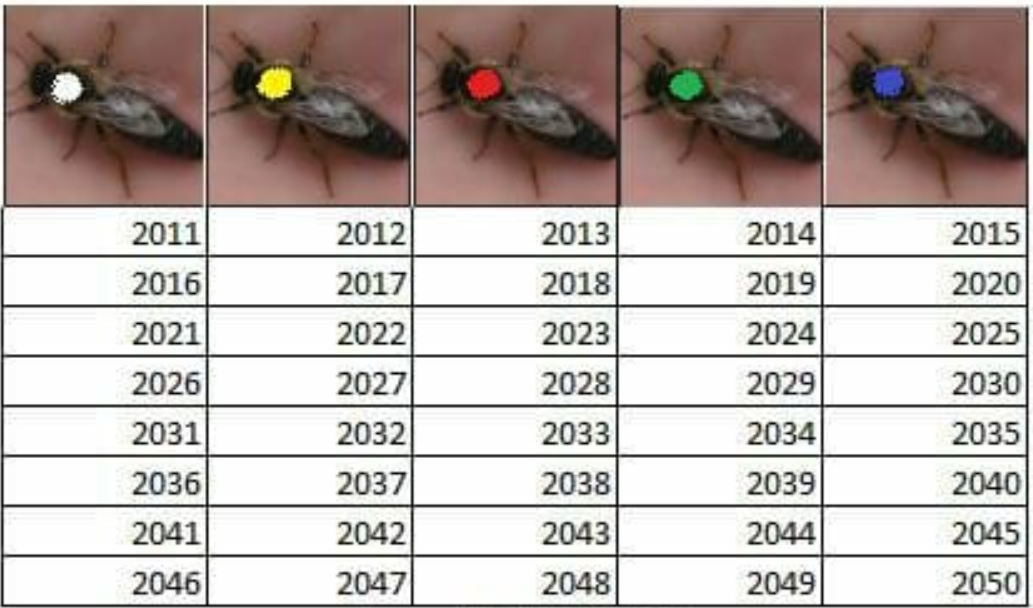In accordance with international agreements, the marking of queen bees is a process that takes place every year.
Why are bees branded
Each beekeeper marks his queen bees annually. Marking is a useful procedure to avoid wasting time in the future due to difficulties in recognising queen bees compared to worker bees, especially in the case of very large swarms.
When a queen is in the midst of other bees it is possible but really very difficult to recognize her inside the combs. Queen bees are marked every year and it is precisely through this method that they can be easily recognized and thus make it easier for beekeepers to quickly identify them.
The colours used for the marking have a precise logical and chronological order that we will analyse later.

What tools are used for marking?
The marking is used to apply a small amount of coloured paint to the back of the bee. The most commonly used colours are usually very vivid with prominent shades so that they can be easily spotted.
The marking of the queen bee can be done through different methods. Depending on the skill and experience of the beekeepers, certain instruments are preferred over others.
What is important to consider in the choice of instruments is one's ability and professionalism in carrying out this operation which does not require much time but requires the intervention of a professional and firm hand.
When you go to apply the paint on the bee, the application pressure must be minimal so as not to damage the animal in any way and not to run any risk to its health but, at the same time, the pressure exerted must not even be too light because in this way if the color is applied incorrectly, it could fade and disappear over time.
Very often, in fact, when the amount of paint is higher or lower than the correct dose or when the pressure exerted is not correct, queen bees lose the colour applied on their back due to rubbing with other bees.
There are two main methods of application: either by direct application and then through an operation that involves the removal of the animal with the use of their hands or through external tools and special kits that hold the animal in small boxes during the short time provided for the application of the color.
For marking we can use various specific products such as lacquers and nitro paints, although it is often more convenient to use simple indelible markers. In some countries it is common to use not only coloured but also numbered discs. In this way it is possible to associate a queen bee to a particular hive.
The practice of marking the queen bee is recommended especially for beekeepers who have a large number of hives as it makes it easier and faster to locate the queen during visits to the apiary.
The drying of the paint, an important factor
When the drop of paint is applied on the back of the bee, it is necessary to wait a minimum of time for proper drying, which will not only preserve the integrity of the colour but also prevent foreign odours from remaining on the queen.
A queen bee with a strong foreign smell is rejected by her workers and consequently rejected or even killed because she is perceived as a stranger and a potential danger.
Therefore, ensuring that the paint applied is dry is an essential step.
Usually the paint that is used is a quick drying product that takes very little time for application but also for drying.
The order of marking colors
There are five colours used for marking.
The order of use starts with the color blue and then proceeds in the following years with an order that respects the alphabetical order of the initials of the colors.
The colour chosen for the marking is not random but follows an international convention based on the year of the Queen's birth. In this way the beekeeper is able to determine the age of the queen.
Being lighter, the alphabetical order and use of colors is precisely this: blue, white, yellow, red and finally green.
Blue is used for all the years ending with the number zero or five, while in the intermediate years of each five-year period the other colours are used in succession.
The international agreements therefore provide for the marking of queen bees every year according to these instruments and the use of this colour scale.
The marking therefore makes it possible to recognize the age and vintage of each bee which is marked identifying its age according to the colour it wears on its back.
In many cases the marking also made it possible to notice the unexpected replacement of the Queen. In fact, it has happened that bees have replaced their queen giving birth to a new brood without the presence of the previously marked queen.
In this case the marking is also useful to understand how the bees behaved and any replacements.

 English
English  Italiano
Italiano  Estonian
Estonian  Finnish
Finnish  Français
Français  Deutsch
Deutsch  Latvian
Latvian  Norsk
Norsk  Polski
Polski  Română
Română  Español
Español  Svenska
Svenska